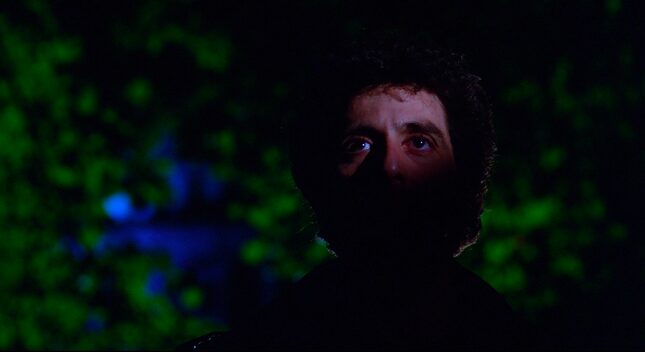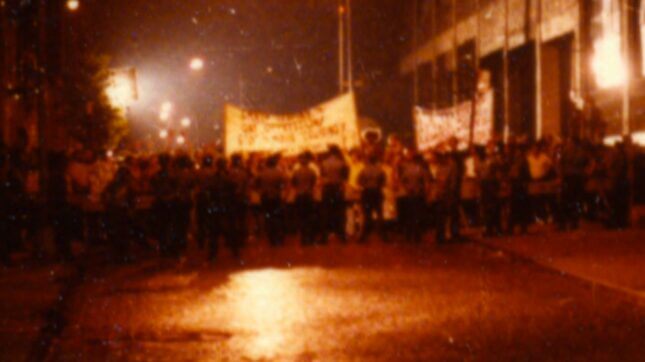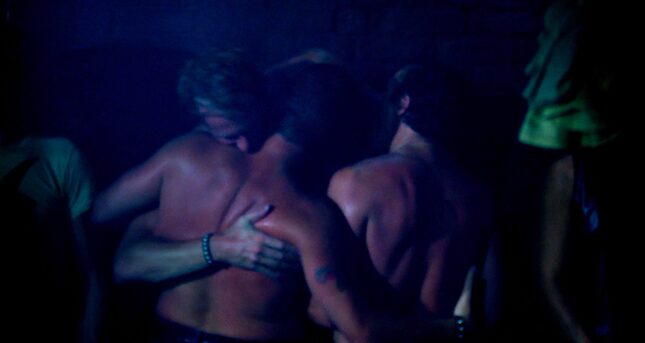

While it filmed in New York during the summer of 1979, gay activists tried to cancel Cruising. They made noise outside the film’s shooting locations, some going as far as to make their way into adjacent apartments so that the commotion was mere walls away. From rooftops, they pointed reflectors at the cast and crew to mess with the shoot’s lighting. The New York Times reported that on July 26, 1979, a gathering of about 1,000 people marched through Greenwich Village in protest of the film that the National Gay Task Force, a nonprofit group of activists, claimed “represents a gross distortion of the lives of gay men by portraying them as violent and sex‐obsessed.”
Members of the group had gotten their hands on its screenplay, which director William Friedkin had adapted from Gerald Walker’s 1970 novel of the same name about a serial killer stalking gay men. Ethan Geto, described by the Times as “a spokesman for an ad hoc group of homosexual activists opposed to the film,” compared the filming of Cruising in gay-heavy downtown New York to “the Ku Klux Klan making a movie about the black community on 125th Street in Harlem.”

The groups had been riled up, apparently, by Village Voice writer Arthur Bell, who in his July 16 column, had issued a call to action over a movie that he said “promises to be the most oppressive, ugly, bigoted look at homosexuality ever presented on the screen… the worst possible nightmare of the most uptight straight. I implore readers… to give Friedkin and his production crew a terrible time if you spot them in your neighborhoods.” Later, according to Nathan Lee in a retrospective Voice piece in 2007 pegged to the movie’s DVD release, Bell bragged to critic Janet Maslin, “What the Declaration of Independence was to Jefferson, that column was to the gay community.”
In the summer of ’79, the cups of angry gays runneth over with exaggerated metaphors. By August, about two weeks after the thousand-person march, the National Gay Task Force had retracted a demand that the city deny the filmmakers permission to shoot in New York, admitting “its actions smacked of censorship,” according to the Times. Indeed, it did, but the protests’ motivation wasn’t irrational, per se. Gay representation was so rare in pop culture at the time that stakes were high. It’s not that gay people were incapable of doing terrible things to each other—gay people know this better than anyone—it’s that they were so rarely portrayed in mainstream pop culture, let alone mainstream pop culture produced by a major studio, helmed by one of the most respected directors of his time (whose The Exorcist was nothing short of a phenomenon), and carried by a bonafide movie star (in this case, Al Pacino).
Cruising threatened to poison the well by taking up disproportionate cultural space with a negative movie that probed the dangers of gay congregation and sex. Assuming audiences would be too stupid to know the difference between real life and a movie is its own ideological shortcoming, though given the rampant homophobia in American culture, the activists weren’t exactly irrational there either. It made a certain sense to assume that such a movie could somehow be weaponized against gay men.
But had they been successful, we would have missed out on a valuable document of gay history. Time has been kind to Cruising in proving the activists wrong. I’m glad they failed. In 2020, when explicit depictions of gay sex are just a few clicks away and play integral roles in prestige entertainment, Cruising is doing less heavy lifting in terms of representation. We can see it not as the statement but a statement, and, more specifically, as a relic. It is a document of a lost time and place that nonetheless remains relevant to modern fears and practices. It’s a time capsule, and yet so much of its imagery would look familiar to anyone who has cruised the neo-liberation public-sex scene of New York that was thriving, pre-quarantine. Cruising was ahead of its time, even more so than the progressives who attempted to shut it down.

Friedkin, producer Jerry Weintraub, and Pacino were interlopers, outsiders to the gay leather/S&M scene their film depicted. In a 2007 documentary about the making of Cruising, Friedkin and Weintraub recalled immersing themselves in the scene, effectively doing the work of the Cruising protagonist Steve Burns (Pacino), an undercover cop who poses as a leather gay to investigate a spate of recent murders. Accordingly, Friedkin’s eye leers and camera roves over cavorting extras, whom he’s said were picked from the actual gay leather scene at the time. Many of them seem to be hooking up on camera, and Friedkin’s claim that he deleted some 40 minutes of more explicit gay sex from the bar scenes (only to lose the footage, whose legendary status inspired the 2014 James Franco/Travis Matthews film Interior. Leather Bar.), would seem to back that up.
In his retrospective Voice piece, Lee wrote that Cruising was “filmed in such legendary bars as the Ramrod, Anvil, Mine Shaft, and Eagle’s Nest (the latter two eventually barred Friedkin from the premises),” though Wikipedia says that it was actually shot at the Hellfire Club, “which was decorated to resemble the Mineshaft.” Regardless, none of these places exist anymore and that they were filmed and/or recreated at all makes Cruising invaluable from a documentary standpoint. A murder mystery set in this world is not the ideal method of preservation, but it’s better than the nothing we would have in its absence. It reminds me of the case files I’ve read from various sex-club/-bar shutdowns in the city in which undercover officers documented sex acts that violated the health code in the driest possible language. Were they not in legal documents casting them as contraband, these acts would likely have been forgotten forever, even by the people involved (if they’re still alive).
At any rate, he does dance like a straight guy.

I mean, really.

At no point do any of the dozens of men that he encounters ever suspect that he’s in gay drag. He’s readily accepted. His butch appearance was de rigueur in the days of gay clones, and he adopts no particular affect to help pass as gay. He shows up and gets down. At a time when the vast majority of the few gay men (and portrayals of them) that made it to the mainstream were lisping and limp-wristed queens (not that there’s anything wrong with that!), Cruising was completely at peace with the notion of gay masculinity.
Friedkin rather openly does pathologize gay sex to some degree—the film’s first murder is intercut with a few frames of anal penetration, making explicit the connection between the killer’s knife and his dick.

Cruising was released over a year before the first reported cases of AIDS, and its linking of gay sex and death would come to seem morbidly prescient. Today, what this movie gets at that no other has nearly as well is a more universal anxiety about anonymous sex. In an age of hook-up apps and socially acceptable casual sex, people all over the sexual spectrum effectively put their lives in the hands of strangers in the name of fun, over and over again. The vast majority of these encounters end peacefully, but it’s hard to ignore the vulnerability one exhibits when naked with a stranger, and how easy it would be to exploit that vulnerability. Cruising envisions a worst-case scenario.

After the killer is caught, we see someone else from behind with a similar physical profile entering a club. A superficial interpretation of this is that there’s more than one killer on the loose, but the open-ended nature of the film’s ending does feel like an indictment of the greater community by straight men (or at least, given their extensive romantic histories with women, we can safely assume Friedkin, Weintraub, and Pacino all identified as straight when making this movie).
“I had no intention of making a statement, one way or the other, about what was happening in the leather bars,” recalled Friedkin in 2007. “I went in pretty much with documentary-type cameras and recorded what I saw. And there’s no comment made in the film about what the audience is seeing.” Previously, this noncommittal ethos was interpreted as being betrayed by the film’s lurid and negative nature. Today, it feels more like a right move than a wrong one. Cruising gets better every time I watch it. As a parable of the hazards of anonymous sex, it is useful (albeit sensationalized). As a warp back to a land that many would prefer time to forget, it is simply indispensable.